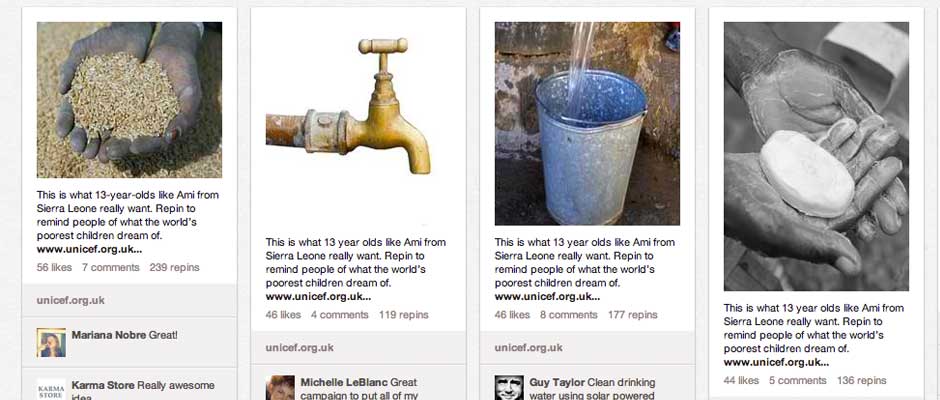Of all the NGOs using social media at the moment, UNICEF seems to be one of the most creative. Three current campaigns cut through the usual noise to make an impact in the perceptions of the viewer. And that’s not including the day-to-day campaigns it runs, including the recent Sahel campaign, or the offline campaigns such as the bread-for-good campaign…
The first was on Pinterest, a campaign released last month. UNICEF has been on Pinterest for a while (it has 36 boards with more than 1000 pins) but this campaign was the fictional Pinterest account of Ami Musa, on a board called “Really Want”. Each pinned image is of something a child in a developing country might want, like grain or water. Clicking through on the pins takes you to a dedicated donation page on the UNICEF UK website.
For those who are new to Pinterest, the trick here is always to pin from your own site. The campaign and donation page would be created first and then the images would be pinned to Pinterest.
With only one board and nine pins, the campaign garnered international attention but barely more than 1200 followers on Pinterest itself (UNICEF only has 5,000 followers on Pinterest for its main account). The images would have popped up in the “all pins” space on the day they were posted and then sporadically as they were re-posted by the followers.
As a visual campaign, it’s a very clever intervention in the overtly consumerist space that is most of Pinterest. The images are a stark reminder of how some people’s basic needs remain unmet while others are pinning extravagant images of dream bathrooms dripping with greenery and brass.
The descriptions on the pins were never written in the voice of “Ami” though. Each one is written in the third person and says “This is what 13 year olds like Ami from Sierra Leone really want. Repin to remind people of what the world’s poorest children dream of.”
It would be interesting to see what happened with this campaign if real children were encouraged to pin on a regular basis and the campaign became a space for teenagers around the world to interact with each other and learn about very different lives. Pinterest is a relatively safe place to do this, given its “no porn” policy, especially if the project were restricted to teenagers.
The second campaign of note was the recent video for the International Day of Handwashing. Without your camera device enabled, the video showed a first-person view of hands undertaking a variety of activities and slowly getting greener/browner as dirt and germs were picked up. These bugs made visible were passed from one person to another via door handles, handshakes and so on. At the end, a doctor washes those hands and, naturally, the muck comes off and washes down the sink.
If you do enable your camera, then the last screen has the invisible person look into the mirror… and it’s your own face looking back. The clever tag line is “share the message, not the germs”.
That all makes it surprising that the third campaign, A Promise Renewed, is a fairly dull web site with a hashtag and Facebook to go with it. What this project really needed was a similar set-up to the World Humanitarian Day “I was here” project, with on-site pledges and built-in sharing mechanisms combined with a world map.
